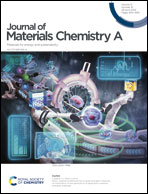New insights into the charge storage chemistry of polymer cathodes in aqueous Zn batteries†
Abstract
Redox polymers for aqueous rechargeable Zn-ion batteries have a large variety of types, and can be exploited to build air-rechargeable batteries due to their spontaneous oxidation. Yet, understanding of the amorphous polymer cathode is insufficient. Here, the dominant role of H+ in the charge storage process of aqueous Zn–organic batteries and factors that influence the fraction of H+ uptake in a polymer cathode are unveiled both experimentally and theoretically. Four different polymers containing amino or carbonyl groups, or both, are used to make cathodes, and their percentages of H+ uptake are experimentally determined. The percentage of H+ uptake is 61–66 at% in the four polymer cathodes. A higher H+ uptake fraction in the polymer also corresponds to a higher contribution fraction of the diffusion-controlled charge storage process and higher activation energies in both the redox reaction and ion diffusion. The Zn2+-insertion leads to greater change of entropy than the H+-insertion. The polymer with a higher H+ uptake fraction (i.e., less Zn2+ uptake) is subject to a smaller change in entropy. The H+-involved redox reaction is facilitated by lower activation energy and more negative change in Gibbs energy, accounting for more H+ than Zn2+ in the polymer cathode.



 Please wait while we load your content...
Please wait while we load your content...